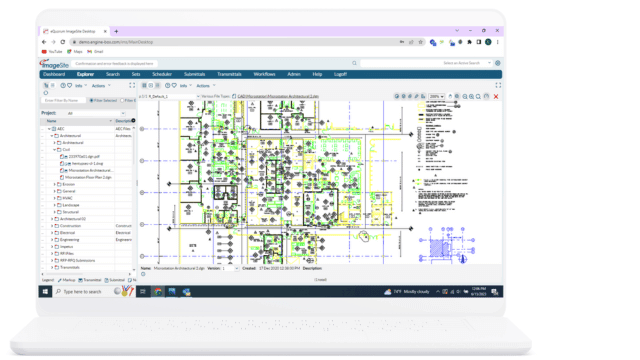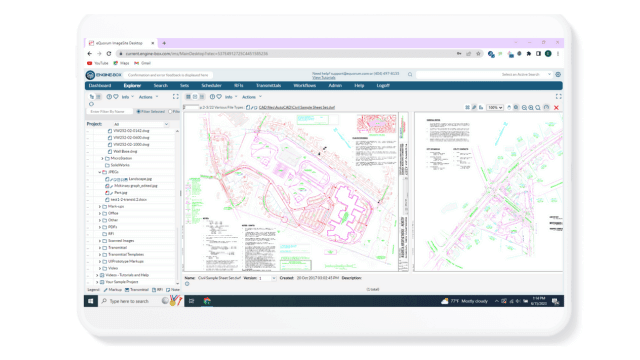What Is a Version Control System and How Does It Work?
What Is a Version Control System and How Does It Work?
Version control (sometimes known as revision control or source control) is often used in drafting and design workflows. In fact, chances are you have used a form of version control at some point in your life when using Windows to store your files.
As a document moves between hands, it typically goes through multiple revisions before it can be finalized. Versions are usually identified by a number or letter that increases as a new revision is made. For example, the first version of a document is deemed “version 1” and the second “version 2” and so on. This code helps document users identify which version of the document is most current, preventing use of old files, duplicated efforts, and providing an audit trail of changes.
Version control has been further enhanced by modern computing. Though version control systems can be stand-alone applications, mostly today they are embedded in various software applications. A document control system is a prime example of version control-embedded software, since it is typically used by organizations as a place to store and transfer project files.
Version control can be used for a variety of business and engineering applications, and is particularly useful for companies managing CAD files and other engineering documents. Features such as version control automation and check-outs/check-ins are valuable for ensuring the efficiency and accuracy of the project files.
Today, we are all familiar with the “Save As” feature shown in the Microsoft Office Suite. If you guessed this is a form of version control, your right, since it allows file users to create a new version of a document without making changes to the original version. This feature does, however, have its limitations, since it doesn’t limit multiple users from accessing the same document at any given time.
Benefits of Version Control Systems
Version control systems are highly effective for project collaboration, as it allows users to easily share files and stay up-to-date with the latest version. It can also be used as a backup when mistakes are made to the newest version of a document, giving users the opportunity to rework a document without having to start from scratch.
For example, two engineers are editing a document simultaneously. This can often happen when users are telecommuting (working from home) or working in large teams with limited means of communication. Version control software can restrict changes from being applied to the same document as they are made via the system’s configuration, reducing confusion and the disaster of have two of the same files with differing data.
Version Control in a Document Management System
A document management system, sometimes known as a repository, is a database used for the efficient storing of files. In most cases, document management systems require client software and can only be accessed within a network. These systems may have limited functionality and accessibility.
ImageSite, on the other hand, can be accessed via any web browser on any device, including mobile devices like smartphones or tablets. Unlike basic version control systems, it’s an all-encompassing workflow and document management system used to automate business and engineering processes. With ImageSite, version numbering schemes can be changed based on your company’s preferences for managing both major and minor versions of a document.
Not only is the software packed with features, but it also allows companies to maintain the highest level of security available for Cloud document management systems. EngineBox provides users with all the features of ImageSite while helping companies improve efficiency and compliance while working in varied locations.
Additional EDMS Features
Our EDMS solutions
ImageSite and EngineBox are eQuorum’s robust workflow and document management solutions, created to help workers manage their essential workflows while maintaining complete control over their engineering files and documents. Not only do they provide a secure collaboration site for workers, but they also help organizations manage document distribution with third parties like vendors, contractors, and customers. Both systems are offered at a competitive price, enabling organizations to get a quick return on their investment by providing the features and functionality needed to help organizations improve efficiency, productivity, and collaboration. Companies can choose from concurrent user subscriptions or named user subscriptions, ensuring organizations have subscription options that make sense for their business.

ImageSite®
Our single source engineering workflow and document management system. Built in HTML5 so there is no software to deploy to client computers or mobile apps to download. Offered as an On-premise or Private Cloud system.
EngineBox™
EngineBox is a cloud based workflow and document management version of ImageSite that resides outside the corporate network.
Our EDMS solutions
ImageSite and EngineBox are eQuorum’s robust workflow and document management solutions, created to help workers manage their essential workflows while maintaining complete control over their engineering files and documents. Not only do they provide a secure collaboration site for workers, but they also help organizations manage document distribution with third parties like vendors, contractors, and customers. Both systems are offered at a competitive price, enabling organizations to get a quick return on their investment by providing the features and functionality needed to help organizations improve efficiency, productivity, and collaboration. Companies can choose from concurrent user subscriptions or named user subscriptions, ensuring organizations have subscription options that make sense for their business.

EngineBox™
EngineBox is a cloud based workflow and document management version of ImageSite that resides outside the corporate network.
The eQuorum Customer Promise
In 2005, eQuorum developed the first all browser-based EDMS. The system, although for on-premise use, was still created to remove client software and JAVA from user computers and allow users to have a single viewer based on the simple navigation functionality of browsers. Today, eQuorum provides that same application in a private Cloud or a SaaS Cloud option. We can do this because we are, and have always been, browser-based, understanding the enhanced speed, security, and usability of this technology.
With the abundance of document management systems on the market today, there’s no doubt that choosing the right Cloud document management software can be a difficult decision. eQuorum is here to provide a comprehensive, powerful, and most importantly – affordable Cloud document management solution. We believe in providing real value to our customers by eliminating unnecessary costs, providing industry-leading functionality, and equipping your team with the right tools using cutting edge technology to bring your products to market faster.
eQuorum®
We specialize in engineering workflow and document management. Our comprehensive, yet easy-to-use software provides the solution to manage data from design to manufacturing and production, to sales, support and administration.